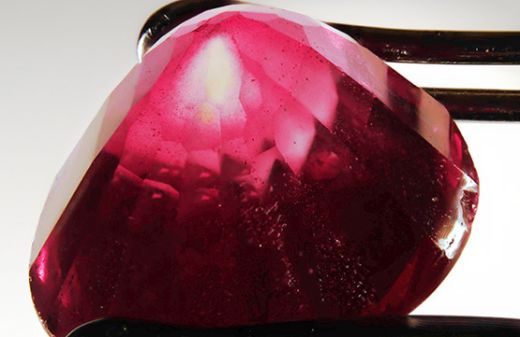GIA Spots Lab-Grown Ruby Layer on Natural Stones
 RAPAPORT...Attempts to upgrade the size and color ofgemstones using a layer of synthetic material have been around for decades, butsigns indicate the techniques are changing.The Gemological Institute of America (GIA) recently received two loose, oval-shaped,mixed-cut, red stones at its New York laboratory. On further inspection, theyturned out to be natural sapphires with a synthetic ruby "overgrowth" - a coverof lab-grown stone that tinted the entire gems red, GIA staff gemologists TylerSmith and Hollie McBride wrote in the Winter 2017 edition of the institute'sjournal, Gems & Gemology.The stones had astrong concentration of reddishness at the junctions of their facets. To thenaked eye, this appeared to come from a treatment called chromium diffusion, inwhich someone adds extra chromium - the chemical element that gives ruby itsdistinctive color - to make the gem redder.However,examinations under a microscope revealed the presence of the overgrowth, andshowed that the main part of the stones was, in fact, natural, almost-colorlesssapphire. In addition, the presence of platinum was consistent with previouscases of synthetic ruby overgrowths.The stones had certain visual features that resembled those with coatings created using a technique known as "Lechleitner" - named for its pioneer, JohannLechleitner - in which a synthetic emerald overgrowth gives greenness to anear-colorless beryl. (By chance, the GIA's Carlsbad lab received one of thosestones for identification at around the same time the red stones arrived at theNew York branch.)Lechleitner, who was active in Austria in the 1960s, also experimented withruby overgrowths. However, the GIA had reason to believe the producers hademployed different growth conditions to coat the New York stone: Lechleitner's overgrowthrubies contained molybdenum, but that element was absent in this case."Although this is not the first report of synthetic ruby overgrowth on naturalsapphire seeds, it marks the first time the New York [or] Carlsbad laboratorieshave had them submitted for identification," according to Smith and McBride."The resurfacing of these vintage overgrowth synthetics shows that once amaterial is in the trade, it is here to stay."Image: Hollie McBride
RAPAPORT...Attempts to upgrade the size and color ofgemstones using a layer of synthetic material have been around for decades, butsigns indicate the techniques are changing.The Gemological Institute of America (GIA) recently received two loose, oval-shaped,mixed-cut, red stones at its New York laboratory. On further inspection, theyturned out to be natural sapphires with a synthetic ruby "overgrowth" - a coverof lab-grown stone that tinted the entire gems red, GIA staff gemologists TylerSmith and Hollie McBride wrote in the Winter 2017 edition of the institute'sjournal, Gems & Gemology.The stones had astrong concentration of reddishness at the junctions of their facets. To thenaked eye, this appeared to come from a treatment called chromium diffusion, inwhich someone adds extra chromium - the chemical element that gives ruby itsdistinctive color - to make the gem redder.However,examinations under a microscope revealed the presence of the overgrowth, andshowed that the main part of the stones was, in fact, natural, almost-colorlesssapphire. In addition, the presence of platinum was consistent with previouscases of synthetic ruby overgrowths.The stones had certain visual features that resembled those with coatings created using a technique known as "Lechleitner" - named for its pioneer, JohannLechleitner - in which a synthetic emerald overgrowth gives greenness to anear-colorless beryl. (By chance, the GIA's Carlsbad lab received one of thosestones for identification at around the same time the red stones arrived at theNew York branch.)Lechleitner, who was active in Austria in the 1960s, also experimented withruby overgrowths. However, the GIA had reason to believe the producers hademployed different growth conditions to coat the New York stone: Lechleitner's overgrowthrubies contained molybdenum, but that element was absent in this case."Although this is not the first report of synthetic ruby overgrowth on naturalsapphire seeds, it marks the first time the New York [or] Carlsbad laboratorieshave had them submitted for identification," according to Smith and McBride."The resurfacing of these vintage overgrowth synthetics shows that once amaterial is in the trade, it is here to stay."Image: Hollie McBride